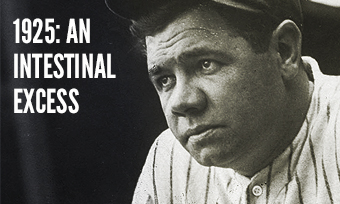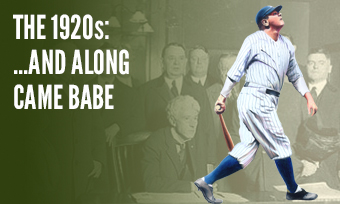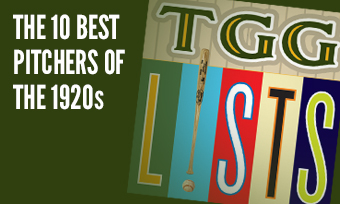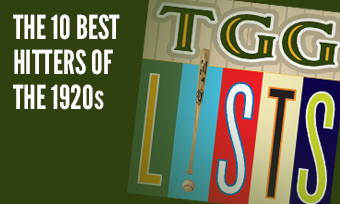The Yearly Reader
Leaders and Honors, 1925
Our list of baseball’s top 10 hitters and pitchers in both the American League and National League for the 1925 baseball season, as well as the awards and honors given to the game’s top achievers of the year.
The National League’s Top 10 Hitters, 1925
Bold type in brick red indicates league leader.
1. Rogers Hornsby, St. Louis
Key Numbers: .403 average, 133 runs, 203 hits, 41 doubles, 10 triples, 39 home runs, 143 RBIs, 83 walks, .489 on-base percentage, .756 slugging percentage.
Rajah batted over .400 for the third time in four years and became one of two players—Ted Williams is the other—to twice win the triple crown.
2. Kiki Cuyler, Pittsburgh
Key Numbers: 153 games, .357 average, 144 runs, 220 hits, 43 doubles, 26 triples, 18 home runs, 102 RBIs, 58 walks, 13 hit-by-pitches, 41 stolen bases.
You name it, Cuyler did it…though he may not have matched some of Hornsby’s stats, he still stunningly represented the NL’s most potent and complete package of numbers.
3. Jack Fournier, Brooklyn
Key Numbers: .350 average, 99 runs, 191 hits, 21 doubles, 16 triples, 22 home runs, 130 RBIs, 86 walks.
A third stellar year in which Fournier easily hit over .300, belted 20-plus homers and knocked in over 100 runs—but advancing age combined with a love-hate affair with Ebbets Field’s more leathery fans would force an end to the good times.
4. Jim Bottomley, St. Louis
Key Numbers: 153 games, .367 average, 92 runs, 227 hits, 44 doubles, 12 triples, 21 home runs, 128 RBIs.
The forecast looked bright for Sunny Jim as the 25-year old evolved into a star presence to go along with Hornsby in St. Louis.
5. Zack Wheat, Brooklyn
Key Numbers: .359 average, 125 runs, 221 hits, 42 doubles, 14 triples, 14 home runs, 103 RBIs.
At 37, Wheat gave one last great go at it before his oft-injured ankle finally got the best of him.
6. George Harper, Philadelphia
Key Numbers: .349 average, 35 doubles, 18 home runs, 97 RBIs.
After wandering about with Detroit and Cincinnati, Harper finally found everyday traction in Philadelphia and saved his best for Baker Bowl (as most Phillies often did), hitting .402 with 12 home runs and 57 RBIs.
7. Pie Traynor, Pittsburgh
Key Numbers: .320 average, 114 runs, 189 hits, 39 doubles, 14 triples, 6 home runs, 106 RBIs.
The superb third baseman was equally good with the bat and became an RBI machine despite a single-digit home run total; it was something baseball would see more of from him in the coming years.
8. Max Carey, Pittsburgh
Key Numbers: .343 average, 109 runs, 186 hits, 39 doubles, 13 triples, 66 walks, 46 stolen bases.
At age 35, Carey won the last of his 10 basestealing crowns; he’d depart the Pirates the following year as a centerpiece of the team’s internal turbulence.
9. Ray Blades, St. Louis
Key Numbers: 122 games, .342 average, 112 runs, 37 doubles, 8 triples, 12 home runs.
The short-lived leadoff spark had a career year and, at one point, safely reached base in 54 straight games.
10. Irish Meusel, New York
Key Numbers: .328 average, 35 doubles, 8 triples, 21 home runs, 111 RBIs.
The year of the Meusels: Irish, along with younger Yankee brother Bob (below) both led their respective New York teams in home runs and RBIs.
The American League’s Top 10 Hitters, 1925
1. Al Simmons, Philadelphia
Key Numbers: .387 average, 654 at-bats, 122 runs, 253 hits, 43 doubles, 12 triples, 24 home runs, 129 RBIs, .599 slugging percentage.
With an MLB-record 85 games garnering two or more hits, Simmons catapulted to superstar status and served notice that the A’s were primed to reclaim the AL penthouse after years in its outhouse.
2. Ty Cobb, Detroit
Key Numbers: 121 games, .378 average, 98 runs, 31 doubles, 12 triples, 12 home runs, 102 RBIs, 65 walks.
For the 38-year-old Cobb, age was nothing but a number—and speaking of numbers, he was part of a Detroit outfielder that hit a collective .369 in 1925.
3. Goose Goslin, Washington
Key Numbers: .334 average, 116 runs, 201 hits, 34 doubles, 20 triples, 18 home runs, 133 RBIs, 27 stolen bases.
Griffith Stadium taketh, and Griffith Stadium giveth; Goslin continued to be robbed of home runs at the voluminous ballpark, but made up by hitting a franchise-record 20 triples (12 of them at home).
4. Harry Heilmann, Detroit
Key Numbers: .393 average, 97 runs, 225 hits, 40 doubles, 11 triples, 13 home runs, 134 RBIs, 67 walks, 19 hit-by-pitches.
In securing his third straight odd-year batting crown, Heilmann batted .479 over his last 29 games—and hit an MLB-record .454 for the season on the road.
5. Tris Speaker, Cleveland
Key Numbers: 117 games, .389 average, 35 doubles, 12 home runs, 87 RBIs, 70 walks, .479 on-base percentage.
Speaker was denied his second batting title at age 37 when Heilmann passed by him with six hits in a season-ending doubleheader.
6. Ken Williams, St. Louis
Key Numbers: 102 games, .331 average, 83 runs, 31 doubles, 25 home runs, 105 RBIs.
The veteran slugger might have matched his monster numbers of 1922 had he not missed the Browns’ final 43 games due to a concussion.
7. Bob Meusel, New York
Key Numbers: 156 games, .290 average, 101 runs, 181 hits, 34 doubles, 12 triples, 33 home runs, 134 RBIs.
Meusel ramped it up as the de facto Yankee bopper in Babe Ruth’s intestinal absence.
8. Sam Rice, Washington
Key Numbers: .350 average, 111 runs, 227 hits, 31 doubles, 13 triples, 87 RBIs, 26 stolen bases.
Rice set personal highs in batting average and hits, but didn’t lead the AL in the latter department despite collecting more than both the year before or after—leading the league both times.
9. Al Wingo, Detroit
Key Numbers: .370 average, 104 runs, 34 doubles, 10 triples, 69 walks.
In his one full season at the major league level, Wingo had the lowest average among the three everyday Tigers outfielders—at .370.
10. George Sisler, St. Louis
Key Numbers: .345 average, 100 runs, 224 hits, 21 doubles, 15 triples, 12 home runs, 105 RBIs.
The Sizzler began the season by hitting safely in 34 straight games, second in Browns/Orioles history to his 41-game run in 1922.
The National League’s Top 10 Pitchers, 1925
1. Pete Donohue, Cincinnati
Key Numbers: 3.08 ERA, 21 wins, 14 losses, 38 starts, 27 complete games, 301 innings, 49 walks.
In a year where no NL pitcher was dominant over the others, Donohue had the best overall collection of numbers; his 2.14 ERA at pitcher-friendly Redland Field certainly helped.
2. Eppa Rixey, Cincinnati
Key Numbers: 2.88 ERA, 21 wins, 11 losses, 287.1 innings.
Ditto Rixey, who won 15 of his games at Redland with a 2.38 ERA.
3. Dolf Luque, Cincinnati
Key Numbers: 2.63 ERA, 16 wins, 18 losses, 4 shutouts, 291 innings.
Another year of frustration for Luque, who posted his fourth losing record over his past five seasons despite decent ERA numbers; his own efforts at the plate weren’t enough, even though just two everyday regulars on the Reds hit more home runs than his two.
4. Dazzy Vance, Brooklyn
Key Numbers: 3.53 ERA, 22 wins, 9 losses, 4 shutouts, .710 win percentage, 265.1 innings, 221 strikeouts, 10 hit-by-pitches.
The Brooklyn ace surpassed 200 strikeouts for the second straight year; no one else during the 1920s could do it even once.
5. Virgil Barnes, New York
Key Numbers: 3.53 ERA, 15 wins, 11 losses.
Maybe Virgil wasn’t living up to the level of success his brother Jesse had enjoyed a few years earlier while a Giant, but he was still quality enough on a staff that was lacking a solid ace until the arrival of Carl Hubbell.
6. Jack Scott, New York
Key Numbers: 3.15 ERA, 14 wins, 15 losses.
Scott lowered his ERA by nearly a run but saw his record drop from 16-7 to 14-15; getting two runs less of support per start had something to do with it.
7. Lee Meadows, Pittsburgh
Key Numbers: 3.67 ERA, 19 wins, 10 losses, 255.1 innings.
As he piled up the wins for the champion Pirates, Meadows was likely thanking—from his knees—the front office folks who got him traded from the horrendous Phillies two years earlier.
8. Larry Benton, Boston
Key Numbers: 3.09 ERA, 14 wins, 7 losses.
Stuck in the Braves’ bullpen for two previous seasons and the first two months of 1925, Benton was finally given an audition for the rotation and won the part—posting a 2.75 ERA with 16 complete games in 21 starts.
9. Bill Sherdel, St. Louis
Key Numbers: 3.11 ERA, 15 wins, 6 losses, .714 win percentage.
After being the Cardinals’ top reliever for much of his previous seven seasons in St. Louis, Sherdel began a new chapter as starter with pleasing results.
10. Ray Kremer, Pittsburgh
Key Numbers: 3.69 ERA, 17 wins, 8 losses, .680 win percentage, 40 appearances, 27 starts, 214.2 innings, six pickoffs.
Languishing to start the year, the 32-year-old sophomore finished not only the regular season strong with eight straight wins, but the World Series as well—taking claim as the winning pitcher in both Games Six and Seven.
The American League’s Top 10 Pitchers, 1925
1. Stan Coveleski, Washington
Key Numbers: 2.84 ERA, 20 wins, 5 losses, .800 win percentage.
The former Cleveland ace gave the Senators the steal of the year after being traded outright from the Indians for two unequivocal benchwarmers.
2. Ted Lyons, Chicago
Key Numbers: 3.26 ERA, 21 wins, 11 losses, 43 appearances, 32 starts, 262.2 innings.
Lyons’ star emergence rose the White Sox to a winning record for the first time since the banishment of the Black Sox Eight.
3. Herb Pennock, New York
Key Numbers: 2.96 ERA, 16 wins, 17 losses, 47 appearances, 31 starts, 277 innings.
Pennock was as workhorse as workhorse got in the AL; his 277 innings were the fewest yet by a league leader in the century to date, and the fewest by an AL leader until Jim Bagby Jr. in 1943.
4. Ted Blankenship, Chicago
Key Numbers: 3.03 ERA, 17 wins, 8 losses.
The common player turned uncommon in the season’s second half, winning 15 of his 17 games after July 13.
5. Walter Johnson, Washington
Key Numbers: 3.07 ERA, 20 wins, 7 losses, .741 win percentage.
An all-around strong effort for the Big Train; he would win 20 games for the last time in his storied career, and set a major league record for a pitcher by hitting .433 in 97 at-bats.
6. Sam Gray, Philadelphia
Key Numbers: 3.27 ERA, 16 wins, 8 losses.
The second-year right-hander from Texas hogged the hype limelight reserved in Philadelphia for high-priced rookie Lefty Grove by winning his first eight starts—going the distance in the first seven of those—before cooling off.
7. Eddie Rommel, Philadelphia
Key Numbers: 3.69 ERA, 21 wins, 10 losses, 52 appearances, 28 starts, 261 innings.
Again making nearly half of his appearances out of the bullpen, Rommel won 14 games as a starter and seven as a reliever as he led the AL in victories for the second time in his career.
8. Red Faber, Chicago
Key Numbers: 3.78 ERA, 12 wins, 11 losses, 32 starts, 16 complete games, 238 innings, 4 stolen bases allowed, 16 caught stealing.
An up-and-down season for the legal spitballer in the middle of his 20-year tenure with the White Sox, but he did a remarkable job eliminating baserunners trying to steal (see numbers above).
9. Slim Harriss, Philadelphia
Key Numbers: 3.49 ERA, 19 wins, 12 losses, 46 appearances, 33 starts, 252.2 innings.
After going 45-76 over his first five years, Harriss was finally able to get over the .500 hump as the A’s evolved into a winner.
10. Jake Miller, Cleveland
Key Numbers: 3.31 ERA, 10 wins, 13 losses.
The rookie righty easily had the best ERA of any Cleveland starter—but also the worst run support. Hence, the losing record.









